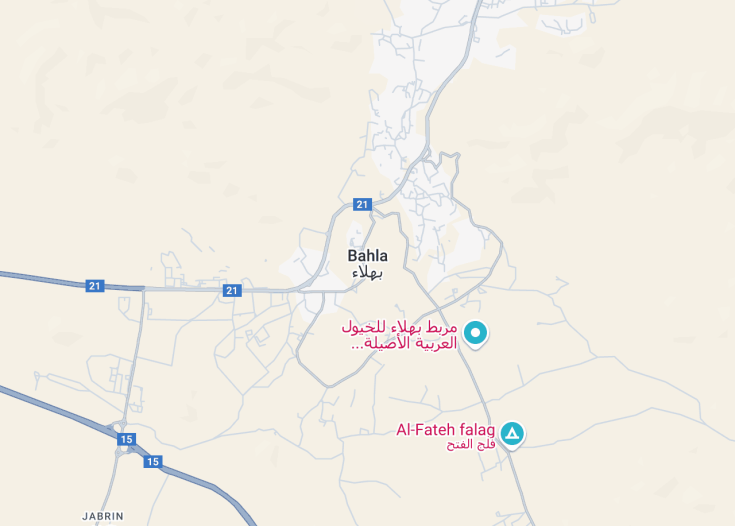Nestled within Oman’s Ad Dakhiliyah Governorate, Bahla is a town steeped in antiquity and mystique. Encircled by a formidable ancient wall, this historic oasis is famed for its UNESCO-listed Bahla Fort, a stunning example of Islamic architecture. Bahla is also renowned for its unique tradition of pottery which continues to be a major attraction. The town, reputed for its tales of sorcery and magical practices, offers a unique blend of cultural history and folklore, appealing to both historians and curious travelers seeking an authentic Arabian experience.
When visiting Bahla, it’s advisable to explore the fort early in the morning to avoid the heat and to experience the quiet ambience of dawn breaking over its historic walls.
Consider coupling your visit to Bahla with a trip to the nearby Nizwa Souq for a full experience of the region’s rich culture and artisanal crafts.
Bahla: An Ancient Oasis in the Desert
| Country | Oman |
| Time in Bahla | GMT+4 |
| Language spoken | Arabic |
| Population | 54,000 (World Population Review) |
| Currency | Omani Rial (OMR) |
| Airports |
|
Bahla, located in the heart of Oman, is enveloped by a rugged desert expanse and fringed by the towering peaks of the Hajar Mountains. This town is not just an ordinary location; it’s a UNESCO World Heritage site steeped in history and filled with stories of ancient civilizations. Bahla is famed for its impressive fort, which dates back to the pre-Islamic period and stands as a testament to Oman’s rich heritage and strategic importance in the region.
The town’s ancient fortress was restored recently, unveiling architectural marvels and details from centuries past, attracting historians and tourists alike. Bahla is also known for its traditional marketplaces where one can find Omani handmade pottery unique to this region. The artisanship displayed here reflects the skills that have been passed down through generations.
With its deep historical roots, Bahla offers a fascinating glimpse into ancient Arab architectural styles and provides insight into rural Omani life. The vicinity of Bahla is dotted with small, ancient villages and palm groves that stand dramatic against the sandy backgrounds, making it a picturesque destination for photographers and adventure seekers. The town is also a gateway for exploring the nearby Jebel Akhdar range which is known for its terraced farming practices unique to the area.
Whether one is delving into the past exploring the iconic fort, wandering through the labyrinthine alleys of the souq, or embarking on rugged mountain adventures nearby, Bahla encapsulates a blend of Omani history and culture with a touch of natural beauty.
Where is Bahla?
Bahla is nestled at the foot of the Jebel Akhdar highlands in Oman, surrounded by desert plains and historic settlements.
Distances:
| Route | Distance by car | Time by car |
| Muscat to Bahla | 120 miles | 2 hours |
| Salalah to Bahla | 560 miles | 10 hours |
What is Bahla famous for?
Bahla is renowned for its formidable historical fort, one of the oldest and largest in Oman, recognized as a UNESCO World Heritage site and known for its distinctive Omani architectural style.
History
Prehistoric Period – Ancient Civilizations
Bahla, located in the Ad Dakhiliyah region of Oman, has a rich history that dates back to the Bronze Age. The area was first inhabited by ancient civilizations that were drawn to its fertile lands and strategic location. Artifacts found in Bahla suggest a thriving community engaged in agriculture and trade.
Islamic Era (7th Century onwards)
The introduction of Islam in the 7th century marked a significant period in Bahla’s history. The town became an important center for learning and religion in Oman. Its strategic location on trade routes contributed to its prosperity and the construction of impressive fortifications, including the Bahla Fort which stands to this day.
Portuguese Occupation (16th Century)
In the 16th century, the Portuguese occupied Bahla as part of their broader strategy to control maritime routes in the Indian Ocean. This period saw the reinforcement of the Bahla Fort and other military structures to protect the town from tribal invasions and rival empires.
Omani Renaissance (1970 – Present)
The modern period of Bahla’s history began with Oman’s Renaissance in 1970 under Sultan Qaboos. Significant efforts were made to restore and preserve Bahla’s historical sites, including the Bahla Fort, which was declared a UNESCO World Heritage site in 1987. Today, Bahla is a symbol of Omani heritage and its ongoing commitment to preserving its historical legacy.
Visit Bahla
What to see and do in Bahla, Oman
In Bahla, visitors can explore the ancient Bahla Fort, a UNESCO World Heritage Site that offers insights into Islamic fortifications and architecture. The town is also famous for its pottery, with local workshops offering demonstrations and products for sale. The nearby Bahla Souq is a vibrant market where one can find traditional Omani crafts, spices, and textiles.
- Bahla Fort
- Pottery Workshops
- Bahla Souq
Annual Events in Bahla
Bahla hosts several cultural events throughout the year, particularly focusing on traditional Omani arts and crafts. The Bahla Pottery Festival, held annually in March, celebrates the town’s rich heritage in pottery-making with workshops, exhibitions, and live demonstrations.
Best time to visit Bahla
The best time to visit Bahla is between October and April when the weather is cooler and more conducive for exploring the outdoor historical sites and local markets.
Is Bahla worth visiting?
Bahla is indeed worth visiting for anyone interested in history, architecture, or traditional crafts. Its well-preserved fortifications provide a glimpse into Oman’s rich past, while its vibrant market and pottery workshops showcase the living traditions of Omani culture. The combination of historical significance and cultural richness makes Bahla a fascinating destination in Oman.









